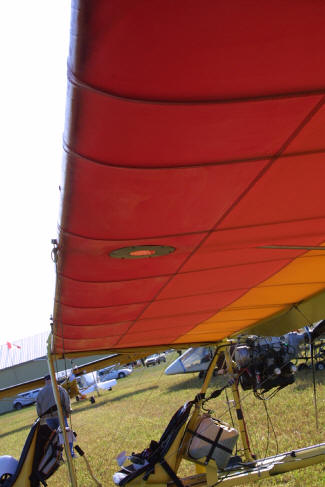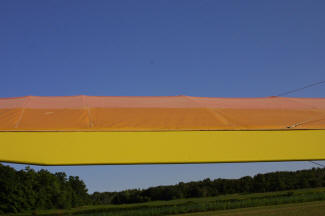|
Ultralight Aircraft need
protection for U.V. - ultra violet rays!
AVIATION OCCURRENCE REPORT WING FAILURE EIPPER-PERFORMANCE QUICKSILVER MX C-IAAM
COWICBAN BAY, BRITISH COLUMBIA
23 OCTOBER 1994
REPORT
NUMBER A94P0245
Summary
The pilot had been working on the ultralight aircraft for about an hour; he then took off, flew for about 10 minutes, and landed. About 10 minutes later, after he had donned a jacket, the pilot took off again far another local flight. Minutes later witnesses observed the ultralight in level flight and at about 100 feet above ground level
(agl). They then heard a loud report and saw the aircraft descend rapidly and strike the ground. The aircraft was destroyed and the pilot was fatally injured.
The wind was calm and the sky was clear at the time of the accident. Weather was not a factor in this occurrence.
The pilot trained and was licensed to fly ultralight aircraft in 1983, and was trained and licensed as private pilot in 1985. He did not maintain an up-to-date pilot log book, but there was evidence that he had about 200 hours flying experience. He had not flown for several months before the accident flight.
The aircraft was manufactured in 1982, and the accident pilot purchased it, ready to fly, in 1983. No maintenance history of the aircraft was found; however, a sales receipt indicated that the dacron fabric wing sails were replaced in 1986.
The aircraft had been kept in a barn on occasion. It was also reported to have spent long periods outside, unprotected from the elements and in direct sunlight, most recently during the several months prior to the accident. There was no evidence that the wings had been covered when the aircraft was kept outside.
The quicksilver wing consists of an upper surface formed by a Dacron fabric wing
sail stretched over the wing frame. The sail is composed of several Dacron panels, sewn together. On inspection, the upper surfaces of the sails were found to be severely faded when compared to the lower surfaces. Further, the dacron fabric was weak and tore easily when stressed.
A sample of the dacron wing fabric was examined by the University of Alberta's Textile Analysis Service. The fabric specialist determined that the fabric had been degraded by sunlight. The tests determined that the tensile strength of the unfaded fabric sample was about 120-130 lbs/in and the faded sample's strength was about 25-40 lbs/in.
There are no Transport Canada regulated design, construction, or assembly standards established for the Quicksilver ultralight aeroplane. Ultralight aeroplanes are exempt from airworthiness certification requirements, and neither a Certificate of Airworthiness (C of A) nor a Flight Permit is required.
The Airframe Maintenance Schedule in the aircraft operating manual recommends that the sail be covered when not in use and that the wing fabric should be removed, inspected and replaced if necessary every two years or 400 flight hours.
Analysis
The dacron fabric sail was not maintained in accordance with the manufacturer's recommendations. Because the dacron fabric was often exposed to the elements and the sun's
ultraviolet rays during the eight~ years since the sails had been replaced, it was severely weakened and it tore when it was exposed to aerodynamic flight loads.
Findings
1. The dacron fabric sail was not maintained in accordance with the manufacturer' 5 recommendations
2. The dacron fabric sail was severely faded and weakened by ultraviolet light.
3. The dacron fabric sail tore when it was exposed to aerodynamic flight loads.
4. The pilot lost control of the aircraft when the sail tore, and the aircraft crashed.
Causes and Contributing Factors
The dacron fabric sail was not maintained in accordance with the manufacturer's recommendations, and was severely weakened by exposure to the
sun's ultraviolet rays. The dacron fabric tore when it was exposed to aerodynamic flight loads.
This report concludes the Transportation Safety Board's investigation into this occurrence. Consequently, the Board, consisting of Chairperson, John W..
Stants, and members Zita Brunet and Hugh MacNeil, authorized the release of this report on 10 May. 1995
Question
How can one tell if their old sails are still airworthy? My sails are a bit
bleached, but seem quite strong. Is there a home built device that will test
the fabric?
Thanks,
Sail condition can be quite deceiving unless a proper test is performed. The fading of the sail definitely means degradation had
occurred. If the blacks are grey and the reds are close to pink, the sail is shot and needs replaced. However, there are chemicals available
to rejuvenate the colors which can mislead the eyeball type tests, since the faded colors means a bad sail but so-so colors don't mean a good
one.
The other concern is the thread used in the sail. Quality sails will use thread that is
immune to UV compared to the basic dacron material. A sail
made with non- stabilized thread will fail often in the seams while in use.
Often , an accident involving the wings, will make large tears in the sail, other than puncture tears. Any sail which exhibits such damage is
not airworthy. A good sail will tear only when severely punched by jagged material from the accident, not due to the shear loads from the
impact with an object.
The best place to check a sail is in an existing slit where battens enter pockets. If the existing slit can be propagated with little effort
the sail is shot. Another method is to give the sail a good solid poke with a finger in a suspect area. If it tears, you did not hurt a 'good
sail'.
| Maule Fabric tester - A
fine quality tool to test fabric covered aircraft for minimum FAA
requirements without removing or punching holes in fabric. Also used to
test struts for inside rusting as required by FAA on all Piper aircraft
with struts. |
 |
| Belt tension tester, can be purchased
with special end for testing fabric. |
 |
A new piece of material will require almost more effort than you can muster to get the point to penetrate the material, the tester will be
stopped as the 45 degree area tries to go through and the actual penetration will make a sound about like a 22 cal 'short' going off in a
small pistol.
Whenever I sell the tester, I include a sample of new cloth to allow some comparative
testing.
|




